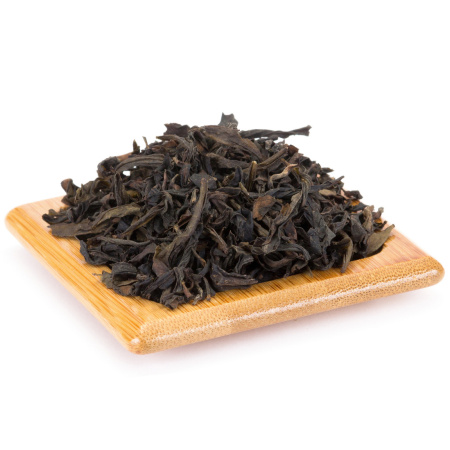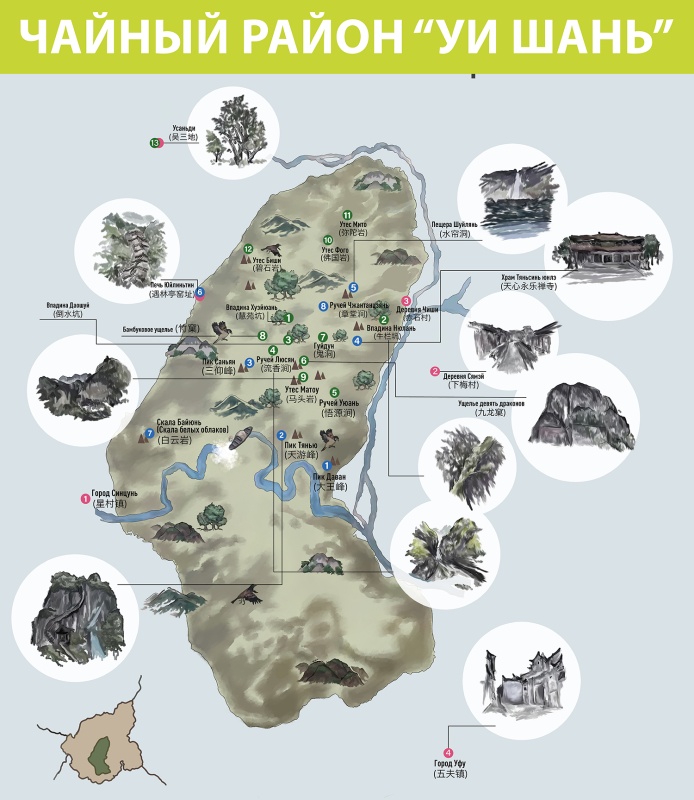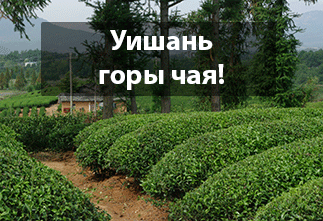trans. "Big Red Robe"
This tea is a type of oolong and is produced in the northern part of Fujian Province, in the territory of Wuyi Mountain. Currently, tea from those very mother bushes is not produced. But the Chinese government at the beginning of the 20th century allowed the cultivation of seedlings from old bushes for subsequent planting. Today, more than 1000 types of various bushes have been bred in the Wuyi Mountains. The most common raw material is from two types - Zhou Gui and Shui Xian. And the government allowed tea blends from different varieties to be called Da Hong Pao. Therefore, anyone wishing to buy Da Hong Pao can choose a ready-made blend, made by a technologist at the factory, or, to their taste, mix their own Da Hong Pao, and then enjoy its magnificent taste and pleasant aroma.
According to legend, a Chinese man named Ding Xian, who lived in the 14th century, was walking to take an exam to obtain an important rank one hot day when he suddenly lost consciousness. He was lucky because there was a monastery nearby and a monk saw him and made him a cup of tea. The young man came to his senses and continued on his way. He successfully passed the exam before the emperor, and did not forget about his savior. In gratitude for the service rendered, Ding Xian presented the monk with his red robe with a dragon embroidered on it. This clothing was a sign of the power he had received. When the Buddhist monk, due to his inherent modesty, did not accept this gift, Ding Xian covered the tea bushes with his red robe, which brought him healing.
Another legend tells us about incredibly smart monkeys that lived (and live now, and they are really quite smart) in Wuyishan. Since the little ones were smart, the locals learned to train them to collect tea growing on the cliffs where it was difficult to get to. So that the little pickers would not be accidentally caught for dinner by neighbors, they were dressed in little red robes. The tea got its name from the clothes. ))
Da Hong Pao is one of the most popular Chinese teas among lovers of this drink. Its history is shrouded in legends, and its taste will not leave anyone indifferent. But it has acquired the greatest fame due to its special effect on a person's emotional state, since during brewing it relieves nervous tension and at the same time tones.
The taste of brewed tea is very pleasant, delicate and rich, with notes of fruit, caramel, flower honey. An empty cup retains the warm aroma of vanilla, coconut flakes, homemade pastries with raisins for a long time. By the 4th infusion, sweetish citrus notes begin to dominate the taste, and a delicate bitterness appears.
The recommended utensils for brewing this tea are a Yixing clay teapot, gaiwan, or a regular glass teapot. The tea can withstand 7 steepings at a ratio of 5 grams per 150 ml.
The color of the infusion is light amber, with a pear tint. The aftertaste is quite long, fresh, fruity and honey.
Da Hong Pao Light Roast - tea with a strong effect. It warms up the whole body well, calms the nervous system, relaxes well, perfectly lifts the mood and consistently tones.
|
Name in Chinese
|
清香大红袍 |
|
Pinyin
|
qīngxiāng dàhóngpáo |
|
Translation
|
Big red robe |
|
Tea variety
|
Da Hong Pao |
|
Country
|
China |
|
District
|
Wuyishan |
- Комментарии
- Вконтакте
Этот утёсный китайский чай производят на северо-западе провинции Фудцзянь, в горах Уи. По классу его относят к улунам сильной ферментации. Да Хун Пао (大红袍, Da Hong Pao, Большой Красный Халат, ДХП, Дахунпао) — один из самых известных китайских сортов чая — наравне с такими чаями, как Пуэр, Те Гуань Инь и Лун Цзин. Но по количеству легенд и мифов, окутывающих как сам чай, так и его название — пожалуй, на первом месте. Впрочем, это вовсе не означает, что наиболее близкая к истине история происхождения названия этого чая утеряна.
The Wuyi Mountains, and shan, as is known, is translated as "mountain" or "mountains", are located on the border of the provinces of Fujian and Jiangxi. This is a mountain range located on an area of about 1000 square kilometers. The highest point is Mount Huanggangshan, 2158 meters high, which is included in the UNESCO World Cultural Heritage, both for cultural and natural criteria.




















































































